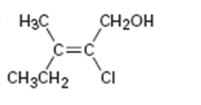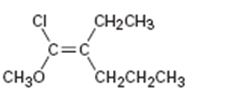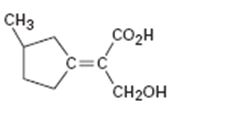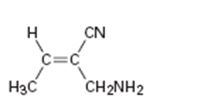
a)

Interpretation:
To assign E or Z configuration for the compound given.
Concept introduction:
The two groups attached to the carbons in double bond are to be ranked first. The member that ranks higher can be determined by considering the
To assign:
The configuration for the compound given as E or Z.
b)

Interpretation:
To assign E or Z configuration for the compound given.
Concept introduction:
The two groups attached to the carbons in double bond are to be ranked first. The member that ranks higher can be determined by considering the atomic number of the first atom of the two substituents separately. The atom with highest atomic number gets the higher rank. If a decision cannot be made by considering the atomic number of the first atom in each substituent then the second, third, fourth atoms away from double bond are considered until the first difference is found. Multiple bonded atoms are considered as equivalent to the same number of single bonded atoms. The isomer that has the higher ranked groups on each carbon on the same side of the double bond is said to have Z configuration. If the higher ranked groups are on the opposite sides, the alkene is said to have E configuration.
To assign:
The configuration for the compound given as E or Z.
c)

Interpretation:
To assign E or Z configuration for the compound given.
Concept introduction:
The two groups attached to the carbons in double bond are to be ranked first. The member that ranks higher can be determined by considering the atomic number of the first atom of the two substituents separately. The atom with highest atomic number gets the higher rank. If a decision cannot be made by considering the atomic number of the first atom in each substituent then the second, third, fourth atoms away from double bond are considered until the first difference is found. Multiple bonded atoms are considered as equivalent to the same number of single bonded atoms. The isomer that has the higher ranked groups on each carbon on the same side of the double bond is said to have Z configuration. If the higher ranked groups are on the opposite sides, the alkene is said to have E configuration.
To assign:
The configuration for the compound given as E or Z.
d)

Interpretation:
To assign E or Z configuration for the compound given.
Concept introduction:
The two groups attached to the carbons in double bond are to be ranked first. The member that ranks higher can be determined by considering the atomic number of the first atom of the two substituents separately. The atom with highest atomic number gets the higher rank. If a decision cannot be made by considering the atomic number of the first atom in each substituent then the second, third, fourth atoms away from double bond are considered until the first difference is found. Multiple bonded atoms are considered as equivalent to the same number of single bonded atoms. The isomer that has the higher ranked groups on each carbon on the same side of the double bond is said to have Z configuration. If the higher ranked groups are on the opposite sides, the alkene is said to have E configuration.
To assign:
The configuration for the compound given as E or Z.
Trending nowThis is a popular solution!

Chapter 7 Solutions
Organic Chemistry
- Consider the reactants below. Answer the following questions about the reaction mechanism and products. HO Clarrow_forwardjulietteyep@gmail.com X YSCU Grades for Juliette L Turner: Orc X 199 A ALEKS - Juliette Turner - Modul X A ALEKS - Juliette Turner - Modul x G butane newman projection - Gox + www-awa.aleks.com/alekscgi/x/Isl.exe/10_u-IgNslkr7j8P3jH-IBxzaplnN4HsoQggFsejpgqKoyrQrB2dKVAN-BcZvcye0LYa6eXZ8d4vVr8Nc1GZqko5mtw-d1MkNcNzzwZsLf2Tu9_V817y?10Bw7QYjlb il Scribbr citation APA SCU email Student Portal | Main Ryker-Learning WCU-PHARM D MySCU YSCU Canvas- SCU Module 4: Homework (Ch 9-10) Question 28 of 30 (1 point) | Question Attempt: 1 of Unlimited H₂SO heat OH The mechanism of this reaction involves two carbocation intermediates, A and B. Part 1 of 2 KHSO 4 rearrangement A heat B H₂O 2 OH Draw the structure of A. Check Search #t m Save For Later Juliet Submit Assignm 2025 McGraw Hill LLC. All Rights Reserved. Terms of Use | Privacy Center | Accessarrow_forwardThe electrons flow from the electron-rich atoms of the nucleophile to the electrons poor atoms of the alkyl halide. Identify the electron rich in the nucleophile. Enter the element symbol only, do not include any changes.arrow_forward
- Hello, I am doing a court case analysis in my Analytical Chemistry course. The case is about a dog napping and my role is prosecution of the defendant. I am tasked in the Area of Expertise in Neutron Activation and Isotopic Analysis. Attached is the following case study reading of my area of expertise! The landscaping stone was not particularly distinctive in its decoration but matched both the color and pattern of the Fluential’s landscaping stone as well as the stone in the back of the recovered vehicle. Further analysis of the stone was done using a technique called instrumental neutron activation analysis. (Proceed to Neutron Activation data) Photo Notes: Landscaping stone recovered in vehicle. Stone at Fluential’s home is similar inappearance. Finally, the white paint on the brick was analyzed using stable isotope analysis. The brick recovered at the scene had smeared white paint on it. A couple of pieces of brick in the back of the car had white paint on them. They…arrow_forwardCite the stability criteria of an enamine..arrow_forwardCalculate the pH of a 0.01m solution of acetic acid use pka of 4.75arrow_forward
- What is the product of the reaction? F3C. CF3 OMe NaOH / H₂Oarrow_forwardWhat is the product of the reaction? F3C. CF3 OMe NaOH / H₂Oarrow_forwardWhat would you expect to be the major product obtained from the following reaction? Please explain what is happening here. Provide a detailed explanation and a drawing showing how the reaction occurs. The correct answer to this question is V.arrow_forward
- Please answer the question for the reactions, thank youarrow_forwardWhat is the product of the following reaction? Please include a detailed explanation of what is happening in this question. Include a drawing showing how the reagent is reacting with the catalyst to produce the correct product. The correct answer is IV.arrow_forwardPlease complete the reactions, thank youarrow_forward
 Organic ChemistryChemistryISBN:9781305580350Author:William H. Brown, Brent L. Iverson, Eric Anslyn, Christopher S. FootePublisher:Cengage Learning
Organic ChemistryChemistryISBN:9781305580350Author:William H. Brown, Brent L. Iverson, Eric Anslyn, Christopher S. FootePublisher:Cengage Learning
 Introduction to General, Organic and BiochemistryChemistryISBN:9781285869759Author:Frederick A. Bettelheim, William H. Brown, Mary K. Campbell, Shawn O. Farrell, Omar TorresPublisher:Cengage Learning
Introduction to General, Organic and BiochemistryChemistryISBN:9781285869759Author:Frederick A. Bettelheim, William H. Brown, Mary K. Campbell, Shawn O. Farrell, Omar TorresPublisher:Cengage Learning


